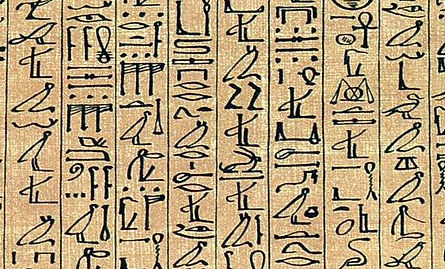



When it comes to ancient Egyptian agriculture one cannot underestimate the importance of industrial crops such as Papyrus &
Flax. Both of these plants are indigenous to Egypt and were highly valued by the ancient Egyptians.
The symbol for the Papyrus plant can be seen all over ancient Egyptian art & architecture and is the symbol of Lower Egypt. (Evans 2008) What made this plant so unique was its strength and durability to withstand Egypt’s dry climate yet it was thin and light enough for easy transport. This reed plant was most notably used as paper. The word “Paper” even comes from the word “Papyrus”. It was when the ancient Egyptians discovered their written language, sometime around the 1st Dynasty, that there was a need for a writing material. (Dunn 1996-2013) The making of papyrus was a tedious process. First the fresh stalks would be soaked in water for varying periods of time, and then the stalks would be split to remove the tissue inside, known as the pith. Once the pith is removed they are laid on top of each other in two opposing layers then they are pressed and beat together to become flat. This process causes the pith to ooze a glue-like substance that seals it all together. Once dried, you are left with a sheet of papyrus ready to be used for religious or literary works for all to enjoy for future generations. (Evans 2008)
The Papyrus plants versatility encompassed all of the ancient Egyptian needs from
industrial to domestic. It was with this same plant that they were able to make large
sturdy pieces of furniture to delicate sandals. The uses for this marsh dwelling plant
are endless.The reeds on the plant are so strong that they were even used to build boats
to sail up and down the Great Nile River; (Bard 2007, p. 60)
which I’m sure propelled the ancient Egyptians into the foreign trade market.
Another versatile and resilient cultivated plant found in Egypt is the Flax.
The production of the flax plant was as fundamental to the ancient Egyptians daily life as the Cotton plant is to our life today. Flax was the primary textile fiber used to make the majority of the linens used in Ancient Egypt. This fiber was most important in the wrapping and preservation process used for mummification. (Bard 2007, p. 84) Similar to the Papyrus, the flax reeds are soaked in water, separated into several parts, beaten and then spun into fiber thread. This thread is then used in the production of mats, ropes and clothing. The seeds of the flax plant were pressed into oils. This oil would be used in food, medicines and even religious practices. (SaskFlax)
This utilization would spread to other surrounding countries in the years that followed. The flax plant today is mostly used for
consumption. Had it not been for our Egyptian ancestors, we may have never known about the flax plant.
It would be hard to image ancient Egypt without all the industrial & domestic components that the Papyrus & Flax Plants had to offer. The amazing versatility of these plants could only be as great as the minds that discovered their possibilies
Works Cited
Bard, Kathryn A. An Introduction to the Archeology of Ancient Egypt. Malden, MA: Blackwell Publishing, 2007
Dunn, Jimmy. “Historical Papyrus”, Egyptian Papyrus Historically (1996-2013)
http://www.touregypt.net/featurestories/papyrus.htm
Evans, Elanine A. “Papyrus: A Blessing upon Pharaoh, Occasional Paper”. McClung Museum of Natural History and Culture (2008) http://mcclungmuseum.utk.edu/papyrus/
SaskFlax : Flax History (1997)
http://www.saskflax.com/flaxhistory.html#

The Gifts of the Nile
The Industrial & Domestic Benifits of
Papyrus & Flax in Ancient Egypt
By Sarah Katsuleres

